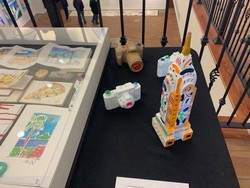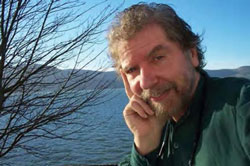Forget “Dancing With the Stars.” University students and faculty danced around the world as the Juan Calderon’s Cultural Explosion Dance Company presented 10 different dances from the Hispanic culture at the Lauren K. Woods Theatre on September 28.
This was part of National Hispanic Heritage Month, which ends on October 15, and sponsored by the School of Humanities and Social Sciences and the Hispanic Heritage Month Committee.
Before the show, first-year student Becca Zidik, sophomore Amina Devries, and senior Jess Weygant, who attended for Dance Appreciation, said they could apply their class to this performance. “We can watch, and we can picture all the different techniques used in the live performance,” Zidik said. Devries said seeing this show could help “learn some new dance moves.”
The show began with Judy Ramos, Assistant to the Dean of the School of Humanities and member of the Hispanic Heritage Month Committee, introducing herself and Calderon.
She said he graduated with a MBA in business and combined his degree with his passion for dancing. Ramos also said he has visited the University in the past and offered dance lessons, but this year decided on a show.
Next, Calderon thanked the crowd and the departments that sponsored the show. He prepared the audience for the performance by saying it would “take you on a little journey to several countries.”
Calderon said many of the dances shown can be seen in films like Dirty Dancing and TV shows such as “Dancing with the Stars.” Calderon then asked,
“What ties Latin heritage together?” and answered, “Spanish.”
He first introduced the flamenco from Spain. A man and woman took to the stage and gave a loud and vibrant demonstration with claps and stomps. Calderon said flamenco was a mix of different cultures in Spain usually danced by Gypsies but also comprised of elements from the Middle East and Europe. The loud stomping and clapping, Calderon said, is an art form in Spain to help create the music.
The second dance was the tango from Argentina as the two dancers held each other closely and glided around the stage with passion. Calderon said the Tango is “hot, it’s sexy, and it’s easily marketable.”
However, he explained the tango began in the ports of Buenos Aires. There, the men visited the local brothel where they waited in line, and as the mistress had a band play music, they danced with each other. When a French visitor came to Buenos Aires and saw this dance, he brought it back with him, which started its global journey.
Next was the bachata from the Dominican Republic. Calderon said this dance is part of a “new craze” and played at parties, but actually started in poor areas.
He compared it to the Blues in America, where music and dance reflect one’s hardships. “It’s like the tango of the Caribbean,” Calderon said. Calderon performed this dance with a female dance partner and showed how the bachata had the attraction of the tango but with a livelier beat.
Afro-Caribbean was a folk dance from the Caribbean, specifically Puerto Rico, Cuba, and the Dominican Republic. A woman danced with graceful gestures as if praying in a tribe. Calderon said that Afro-Caribbean was meant as a dance for the goddess of storm and wind, where the individual prayed for transformation of virtue and wisdom.
The dancer, Yesenia Fernandez, said of the show, “I see these types of shows like living experiences of different cultures. This is the way to see these cultural performances.”
Peru offered marinera, which experienced technical difficulties but later found its beat. The dancers wore traditional garbs and orbited around each other, hoping to get closer with quick footsteps and strong stomps. Calderon said marinera is a poplar traditional dance in Peru used for courtships.
Cha-cha-cha from Cuba came next and Calderon said that “like salsa, it has roots in folklore dance.” He also said cha-cha-cha had a syncopated rhythm, so it used a beat and a half for the music. The dance “has three steps, which is where cha-cha-cha comes from,” Calderon said.
Calderon returned to the stage for cha-cha-cha with his bachata dance partner. This three-step dance was like a Latin version of the three-step waltz as Calderon and his partner danced across the stage with style.
Colombia’s bullerengue was a quieter dance and featured two women in red and white dresses moving gracefully on the stage. They danced around each other and held hands as if sharing a thought. Bullergenue is a folk dance, Calderon said, where women wear maternity dresses.
The Brazilian dance, capoeira, mixed martial arts and dancing together. Calderon said, “Many hip-hop dancers train in this for one arm stands.” The capoerira dancer incorporated defensive fighting techniques into the dance smoothly from one position to another. The first dance was soothing while the second was lighting fast with punches, kicks, and flips.
As for jarabe tapatio from Mexico (a.k.a. the Mexican hat dance), Calderon said it was influenced by flamenco and that the costumes were similar to the culture.
Loud stomps and shouts of “Hey!” from the male dancer were heard by the female dancer, who screamed back. This part was energetic, and more so when the man dropped his hat on the ground and danced around, giving the performance its name.
The final dance was the salsa but its country of origin depends on who you ask. Calderon said, “A Puerto Rican will tell you Puerto Rico. A Colombian will tell you Colombia. A Cuban will tell you Cuba, and a New Yorker will tell you New York.” However, he said all these countries “have helped create salsa today.”
The salsa was a lively and entertaining way to end this performance. Calderon took to the stage with his female dance partner as they presented a quick and exciting dance that had all the right ingredients of movement and music. When the female dancer was center stage for a solo, she brought this hot dance to life.
As the event ended, Calderon said he would show anyone who had time a quick dance on stage and left people with some advice. He said, “Take your passion and take your education to create your career,” citing how he combined his business degree with dancing.
Music industry majors Janet Mendez and Rob Campbell attended the show and participated in the dance lesson, too. “I thought it was cool. I’m Hispanic, so I like to see the history of [the culture],” Mendez said. Campbell said he enjoyed the salsa and capoeira.
Ramos said to The Outlook events like this are what make National Hispanic Heritage Month so interesting. “What it does is make people aware of Hispanic culture, the richness of the culture, and widens their view of it instead of just music and food. This gives people a clear perspective of Latin culture and educates them,” she said.
While talking to The Outlook, Calderon said he chose to do a performance rather than hold another dance lesson because “normally in dance lessons people are shy.” He said with a performance, shy people can see these dances, which in turn, can “inspire them.”
Calderon said that while sports were his first passion in high school, he discovered dancing at Seton Hall University. He said, to him, dancing is “like a healthy addiction,” and this drove him toward starting the Cultural Explosion Dance Company.
Yet, when it comes to doing what one is passionate about and making it into career like Calderon with dancing, he said, “Everyday, it doesn’t feel like work.”




